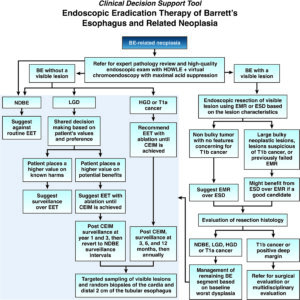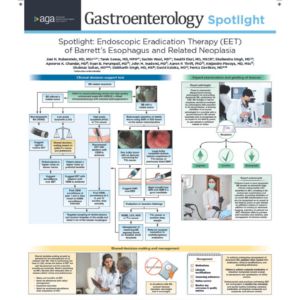AGA has published a new evidence-based Clinical Practice Guideline on Endoscopic Eradication Therapy of Barrett’s Esophagus and Related Neoplasia. This guideline, published in Gastroenterology, establishes updated guidance for Barrett’s esophagus patients.
Key takeaways
- For patients with low-grade dysplasia, it may be appropriate to either remove or monitor the cells. This is a decision doctors and patients should make together after discussing the risks and benefits of treatment.
- For patients with high-grade dysplasia, AGA recommends endoscopic therapy to remove the abnormal pre-cancerous cells.
- Most patients undergoing endoscopic eradication can be safely treated with EMR, which has a lower risk of adverse events. Patients who undergo ESD can face an increased risk of strictures and perforation. AGA recommends reserving ESD primarily for lesions suspected of harboring cancers invading more deeply into the wall of the esophagus or those who have failed EMR.
- Patients with Barrett’s esophagus (dysplasia or early cancer) should be treated and monitored by expert endoscopists and pathologists who have experience in Barrett’s neoplasia.
“While the benefit is clear for patients with high-grade dysplasia, we suggest considering endoscopic eradication therapy for patients with low-grade dysplasia after clearly discussing the risks and benefits of endoscopic therapy. A patient-centered approach ensures that treatment decision is made collaboratively, taking into account both the medical evidence and the patient’s preferences and values. Surveillance is a reasonable option for patients who place a higher value on harms and a lower value on the uncertain benefits regarding reduction of esophageal cancer mortality."

The guideline provides the following general implementation considerations:
- Tobacco use and obesity are risk factors for esophageal adenocarcinoma, so counseling patients to abstain from tobacco use and to lose weight can help improve outcomes.
- In patients with Barrett’s esophagus, reflux control should be optimized with both medication and lifestyle modifications.
“We need to have a conversation with patients in clinic prior to when they show up in the endoscopy unit on a gurney. Patients need to be fully aware of the risks and benefits, both in the short term but also in the long run, to decide which treatment approach is best for them. This decision often comes down to personal factors and values."

Check out AGA’s GI Patient Center resources:















